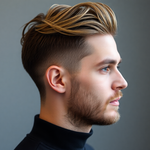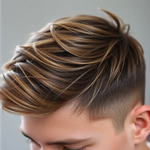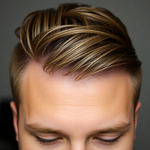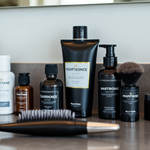
Semi-Permanent Hair Color: A Two-Tone Shade Strategy to Double Looks from a Minimal Men's Capsule Wardrobe
13 October 2025
Share
Semi-Permanent Hair Color: A Two-Tone Shade Strategy to Double Looks from a Minimal Men's Capsule Wardrobe
Struggling to look fresh with a small selection of clothes? Semi-Permanent Hair Color: A Two-Tone Shade Strategy to Double Looks from a Minimal Men's Capsule Wardrobe is the low-risk, high-impact hack that expands outfit options without buying more. In under an hour you can add depth, contrast, and personality—making the same capsule pieces read casual, refined, or intentionally edgy depending on how you style your hair.
Semi-Permanent Hair Color: Why a Two-Tone Strategy Works
A two-tone approach uses semi-permanent dye to layer two complementary shades—typically a neutral base with a lighter or richer accent. Because semi-permanent color sits on the hair shaft rather than fully penetrating the cortex, it fades gradually and causes less damage. That means you get experimentation and versatility without a long-term commitment or major upkeep. The visual contrast draws attention to your face, adds perceived volume, and pairs strongly with neutral capsule wardrobes, doubling looks from the same items.
Who This Guide Is For
- Men aged 18–45 who prefer a minimalist wardrobe but want more variety.
- Guys curious about color but wary of permanent dye or salon costs.
- Anyone aiming to balance low-maintenance grooming with a high-impact aesthetic.
How Two-Tone Hair Doubles Your Outfit Options
Think of your hair as the sixth piece in a five-item capsule. Change the hair tone and the same jacket or tee can read differently:
- Daytime neutral: Muted base tones keep things clean and professional with shirts and blazers.
- Evening edge: Contrasting tips or face-framing accents add an intentional, fashion-forward twist perfect for nights out.
- Casual lift: Sun-kissed or warm tips soften rugged weekend looks.
Choosing Shades That Work With a Minimal Men's Capsule Wardrobe
Pick shades that harmonize with your capsule's dominant colors—navy, grey, black, olive, beige, and denim. Here are reliable pairings that work with most wardrobes and skin tones.
- Natural brown base + caramel or honey tips: Warm, versatile; pairs well with tan boots, olive jackets, and brown leather accessories.
- Dark brown/black base + deep burgundy or navy accents: Understated by day, moody and sophisticated by night; matches black and charcoal pieces.
- Ash brown base + cool steel or silver highlights: Sits cleanly with navy or grey wardrobes and reads modern and refined.
- Light brown base + subtle blonde tips: Best for summer and casual looks; keeps a fresh, beachy vibe with white tees and denim.
Semi-Permanent Hair Color: A Two-Tone Shade Strategy to Double Looks — Placement Options
Placement changes the message. Choose one based on how obvious you want the change to be.
- Subtle tips: Color the last 2–3 inches for a natural, lived-in finish.
- Face-framing accents: Add color to sections around the hairline to draw attention to your features—effective for dates or presentations.
- Underlayer/peekaboo: Dye the underside of the hair for a hidden pop that shows only when you move—great for workplace-appropriate looks with after-hours flair.
- Top-through tips gradient: A blended ombre from root to tip creates movement and visual volume—best for longer hair.
Step-by-Step: DIY Two-Tone Semi-Permanent Application
- Patch test (48–72 hours): Apply a small amount behind your ear to rule out allergic reactions.
- Choose products: Pick a reputable semi-permanent brand and two shades—base and accent. Look for ammonia-free and low-peroxide formulas for less damage.
- Prep tools: Gloves, color brush, bowl, clips, old towel, and petroleum jelly to protect the hairline.
- Section hair: Use clips to isolate the area for your accent tone (tips, underlayer, or face frame).
- Apply base if changing it: If your base needs evening out, apply it first and rinse per instructions. For natural base, skip this.
-
Apply accent: Work quickly and evenly. For tips, comb dye through the ends. For peekaboo, paint underside strands. For face-framing, follow the hairline.
- Blend the transition zone using a toothbrush or fingers to avoid harsh lines.
- Processing time: Follow the product’s time guide—generally 10–30 minutes depending on pigment and desired depth.
- Rinse & condition: Rinse with cool water until water runs clear, then use a color-safe conditioner to seal the cuticle.
- Style & evaluate: Dry and style so you can see how the shades read with your wardrobe lighting (daylight and indoor light can differ).
Pro Tips for a Clean DIY Result
- Work on dry, unwashed hair—natural oils protect the scalp and can help create a softer line of demarcation.
- Start one shade lighter than you want; semi-permanent dyes can oxidize slightly and look deeper when dry.
- Use a paddle brush to feather the transition or a balayage board for precise tip placement.
- If you’re nervous, practice on a hidden underlayer first.
Tools & Product Recommendations
Essentials for a smooth application:
- Color bowl & brush
- Fine-tooth comb for blending
- Clips to section
- Sulfate-free color-safe shampoo and conditioner
- Color-depositing mask or gloss for monthly refreshes
Pro product tip: If you want low-effort maintenance, use a color-depositing conditioner once every 2–3 washes to keep accents crisp. For a curated wardrobe pick that complements many two-tone looks, Menll.com’s minimalist jackets and durable basics provide the perfect clean canvas—pair a navy blazer with ash highlights or a tan bomber with caramel tips to get more use from each piece. Check Menll.com’s collections for staples that work with your new hair statement: Menll.com collections.
Maintenance: Keep Your Two-Tone Looking Intentional
- Wash less often: Aim for 2–3 washes per week to prolong color.
- Cool water: Use cool or lukewarm water to slow pigment loss.
- Sulfate-free products: Sulfates strip dye faster—switch to color-safe shampoo and conditioner.
- Touch-ups: Monthly glosses or diluted semi-permanent refreshes keep accents vibrant without overloading pigments.
- Heat protection: Always use a heat protectant before styling tools to reduce fade and split ends.
Styling for Maximum Wardrobe Impact
Your hair color should amplify outfits, not compete with them. Here are practical pairings for common capsule pieces:
- White tee + denim jacket: Warm tips look sun-kissed and casual—roll sleeves, add a leather bracelet for texture.
- Navy blazer + grey tee: Ash or steel highlights keep this crisp for evening events—go matte with hair product for a refined finish.
- Black bomber + T-shirt: Deep burgundy accents give an under-the-radar statement when you want to look intentional but not flashy.
- Olive field jacket + boots: Caramel or copper tips blend with earth tones for an outdoorsy-but-put-together vibe.
Considerations by Hair Type and Length
- Short hair: Tips and face-framing accents work best—keeps the look easy to maintain and subtle.
- Medium to long hair: Gradients and top-through tips add movement and volume.
- Curly/coily hair: Use cream-based semi-permanent dyes and take care to saturate evenly; colors can appear richer on textured hair.
- Fine hair: Two-tone shading can create the illusion of thickness; avoid heavy, dark contrasts at the roots which can flatten the look.
Troubleshooting & Fixes
- Too bright: Wash with clarifying shampoo once, then re-tone with a darker semi-permanent gloss if needed.
- Brassy tones: Use a cool-toned color-depositing mask (blue/purple-based) to neutralize unwanted warmth.
- Patchy application: Reapply color to thin areas with a small brush and process briefly.
Professional vs. DIY — When to See a Pro
DIY is great for tips, underlayers, and subtle accents. Book a pro if you want:
- Complex multi-dimensional color or precise balayage effects.
- Large-scale lightening (lifting dark hair to blonde requires bleach and professional skill).
- Color corrections after a bad at-home job.
Safety, Allergies, and Credible Guidance
Semi-permanent dyes are generally gentler than permanent formulas, but allergic reactions and scalp sensitivity can still occur. Always follow product instructions, do a patch test, and avoid using expired products. For medical and safety guidance on hair dye use and reactions, see the American Academy of Dermatology’s hair dye safety advice: aad.org: hair dye.
Visual Planning: Use Images and Mockups
Before you commit, create a visual plan. Use a photo of your face and experiment with color overlays in a simple editor or an image generator like Jolt to preview placements. Consider these image suggestions for content and social sharing:
- Before-and-after collage showing subtle tips vs. full gradient (alt text: 'Before and after two-tone semi-permanent hair color on a man').
- Close-up of face-framing accents paired with a blazer (alt text: 'Face-framing hair color paired with navy blazer for evening look').
- Peekaboo underlayer shown with a collar-up movement (alt text: 'Peekaboo two-tone color revealed with movement').

Common Questions (FAQ)
- How long does semi-permanent two-tone color last? Typically 4–8 weeks depending on wash frequency, products, and sun exposure.
- Will it ruin my natural hair? Semi-permanent formulas are low-damage because they don’t use strong developers. Proper aftercare keeps hair healthy.
- Can I go darker or lighter later? Darkening is easy with more pigment; lightening beyond a shade or two often requires bleaching and a professional.
Case Study: From Minimal to Versatile
Meet Alex, 29, young professional with a five-piece capsule: navy chinos, white tee, grey crew, olive jacket, and black boots. He wanted variety without more purchases. We added an ash-brown base and low-contrast steel highlights focused on the top and tips. Results:
- Weekday meetings: Hair styled matte, highlights subtle—read professional.
- After-work drinks: Flip collar and add a sheen product—highlights catch the light, outfit reads intentionally modern.
- Weekend: Messy, textured styling—highlights add dimension to casual denim looks.
Outcome: Same five pieces, three distinct vibes—proof a two-tone strategy multiplies wardrobe mileage.
Final Checklist Before You Start
- Patch-test 48–72 hours ahead
- Select shades that complement your capsule’s palette
- Decide placement: tips, face-frame, or underlayer
- Gather tools and color-safe aftercare
- Plan a touch-up routine (monthly gloss or deposit mask)
Parting Thought and One Call to Action
Two-tone semi-permanent hair color gives you more looks from less clothing—an ideal match for the minimalist man who values versatility and low maintenance. Which two-tone pairing will you try? Share your plan in the comments and browse Menll.com for capsule pieces that let your new shade stand out: Menll.com collections.
Vorheriger Beitrag

Semi-Permanent Hair Color: A Visual Palette Checklist to Match, Mix, and Multiply a Men's Capsule Wardrobe
Aktualisiert am 15 October 2025
Nächster Beitrag

Semi-Permanent Hair Color: How Small Shade Tweaks Make Thrifted Pieces Shine in a Sustainable Men's Capsule Wardrobe
Aktualisiert am 12 October 2025





